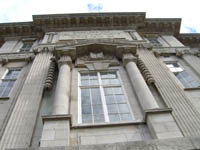Liverpool, UK, September 12-13 2007

The Ashton Building
The Ashton Building, a century-old grade-II listed building, has recently undergone a £5M refit, along with the George Holt Building, to provide state of the art facilities for teaching and research. Besides staff and administration office, the building contains a number of meeting and seminar rooms as well as a modernised lecture theatre on the first floor. The Ashton Building was erected 1912 - 14 for the Faculty of Arts (as the inscription on the quadrangle side of the building notes), to relieve pressure on space in the adjoining Victoria Building. After the migration of the Arts Faculty's departments from the Faculty of Arts Building to the Abercromby Square area in the 1950s and 1960s it was decided to rename the building the Ashton Building. The Ashton Building is linked to the George Holt Building by a door on the second floor. The George Holt Building contains six laboratories equipped with the high specification computing facilities, flat screens, fast internet links, access to printing facilities and a wide range of software. Private study rooms, wireless access rooms and teaching space is also available in the George Holt Building. The George Holt Building was opened, as the George Holt Physics Laboratory, in November 1904. The largest single donation towards the cost of the erection of the building, a sum of £10,000, was contributed by Mrs George Holt and her daughter, Miss Emma Holt. George Holt, who died in 1896, was a founding partner in the Lamport and Holt steamship line; a prominent Unitarian, George Holt was a major benefactor of University College, Liverpool which became the University of Liverpool in 1903. His daughter Emma later left the family home, Sudley, and its contents to Liverpool; which now forms one of the branches of National Museums Liverpool. Amongst the former occupants of the George Holt building are two nobel prize winners, Sir James Chadwick (Physics) and Sir Joseph Rotblat (Peace). The Ashton Building is building number 422 (grid reference D7) on the University Campus Map (PDF). It is just around the corner of the Victoria Building (building 421 on the University Campus Map) which is easily identified by its clock tower. Established in 1892, the Victoria Building inspired the term `redbrick university' which became synonymous with the late 19th Century civic universities in the UK. On Google Maps, the Ashton Building can be found here. |



